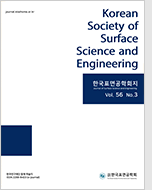
- Past Issues
- e-Submission
-

2021 Impact Factor 1.766
5-Year Impact Factor 1.674
Editorial Office
- +82-2-563-0935
- +82-2-558-2230
- submission@kssse.or.kr
- https://www.kssse.or.kr/

2021 Impact Factor 1.766
5-Year Impact Factor 1.674
The Korean Society of Surface Science and Engineering 2023;56(3):192-200. Published online: Jun, 27, 2023
DOI : 10.5695/JSSE.2023.56.3.192
Graphene, a two-dimensional material, has shown great potential in a variety of applications including microelectronics, optoelectronics, and graphene-based batteries due to its excellent electronic conductivity. However, the production of large-area, high-quality graphene remains a challenge. In this study, we investigated graphene growth on electrolytic copper foil using thermochemical vapor deposition (TCVD) to achieve a similar level of quality to the cold-rolled copper substrate at a lower cost. The combined effects of pre-annealing time, graphenized temperature, and partial pressure of hydrogen on graphene coverage and domain size were analyzed and correlated with the roughness and crystallographic texture of the copper substrate. Our results show that controlling the crystallographic texture of copper substrates through annealing is an effective way to improve graphene growth properties, which will potentially lead to more efficient and cost-effective graphene production. At a hydrogen partial pressure that is disadvantageous in graphene growth, electrolytic copper had an average size of 8.039 ㎛2, whereas rolled copper had a size of 19.092 ㎛2, which was a large difference of 42.1% compared to rolled copper. However, at the proper hydrogen partial pressure, electrolytic copper had an average size of 30.279 ㎛2 and rolled copper had a size of 32.378 ㎛2, showing a much smaller difference of 93.5% than before. This observation suggests this potentially leads the way for more efficient and cost-effective graphene production.
Keywords TCVD; Copper; Graphene.